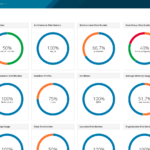Oracle Service Cloud enables enterprises worldwide to handle over 1.3 billion customer service interactions each year. It does this through its strong capabilities in digital engagement and knowledge management.
Companies need to integrate OSC with other applications and platforms to optimize efficiency, productivity, and customer experiences. This is crucial for optimizing efficiency, productivity, and customer experiences.
This article analyzes the components of OSC. It discusses how these components enable impactful integrations. The article will also shed light on common integration hurdles. Furthermore, it will provide actionable strategies for driving operational efficiency through integration optimization.
Core Capabilities That Enable Seamless Integration
Omnichannel Customer Service and Support
- Integrate voice, email, chat, social media, and SMS in a cloud contact center. Use a unified console to manage the entire customer journey. This includes context-based interactions.
- CRM integration allows you to share customer data, interaction histories, and case details. It also provides support for integrating CRM and helpdesk platforms. You can even access service analytics through this integration support.
- Various features, such as case management and knowledge search, equip the agent desktop. These include case management, knowledge search, contact data access, and productivity enhancements. Some of the productivity enhancements are auto-suggestions and machine learning-based article recommendations.
- Business intelligence tools provide packaged analytics for customer service metrics. These tools offer analytics across various channels. It displays them using dashboards, reports, and visualizations.
The call center software integration for Oracle is a game-changer. It emerges amidst these innovations. The integration boosts Oracle systems’ efficiency. It combines omnichannel support with Oracle’s robust capabilities.
Knowledge Management for Intelligent Self-Service
- Maximize knowledge leverage through contextual recommendations in service interactions.
- Public community forums foster user-generated content, integrating company knowledge bases and agent interactions. Company knowledge bases and agent interactions can integrate with these forums.
- Governance tools assist in managing localized, multi-lingual content development. These tools provide easy approvals routing, translation workflows, asset tracking, and publishing controls.
- The personalization engine, using machine learning algorithms, helps users find relevant articles faster. It does this through machine learning algorithms. These algorithms adapt recommendations based on topics, content usage analytics, and customer attributes.
Pre-Built Integrations & Customization Potential
OSC offers over 300 out-of-the-box integrations with enterprise applications, speeding up adoption across various platforms:
- Customer data platforms like SFDC, Oracle CX Cloud, and SAP C/4HANA
- ERP tools such as SAP, Oracle Cloud ERP, and Microsoft Dynamics
- IoT and field service solutions for contextual engagement
- Payment processing solutions for order management
- Marketing automation platforms to orchestrate cross-channel campaigns
- HR information systems for swift employee onboarding
- ITSM tools for streamlined incident management workflows
- It allows custom code integrations via REST APIs, web services, JavaScript embeds, and iFrames
This extensive interoperability unlocks significant connectivity potential across modern business ecosystems.
Despite its digital capabilities and pre-built integration tools, OSC faces challenges when executing comprehensive application integrations. These challenges involve both technology and business hurdles that most enterprises encounter.
Let’s dive deeper into these challenges before discussing potential solutions.
Notable Challenges in Integrating Oracle Service Cloud
While OSC enables scalable, high-value integrations, companies often grapple with the following issues:
1. Data Fragmentation Leading to Poor Insights
Since business tools operate in silos, vital data gets trapped across systems causing:
- Data gaps that provide fractured visibility into customer histories
- Duplicate entries resulting in inaccurate analytics
- Degraded data quality with asynchronous updates that create conflicting records
- Compliance risks from scattered data without proper governance
According to SnapLogic’s research, over 63% of businesses lose significant revenue due to data issues. These issues result in an average of $9.7 million in direct costs.
2. Technical Constraints in Legacy Platform Integrations
Integrating OSC with outdated, monolithic systems like:
- For example, on-premise ERPs offer limited custom integration options
- Mainframe databases: inflexible schemas and access controls
- Custom APIs in legacy tools: complex, insecure, and unstable interfaces
This leads to pain points like:
- Development bottlenecks that inflate timelines and costs
- Run-time errors causing business workflow disruptions
- Cost overruns from complex customization
Adapting legacy platforms to support new technology integrations poses significant challenges. 80% of businesses admit facing notable challenges in this area.
3. Achieving Optimal Flexibility for Future Needs
With customer expectations and market dynamics evolving, systems must have built-in flexibility for:
- New partnership integration: adding emerging value-chain players
- M&A activities: assimilating new business units
- Geographical expansion: scaling globally
- New channel support: adding social commerce, metaverse engagement, etc.
Enabling integrations is crucial for agility. But, it is challenging for most integration leaders. Over 74% of them seek innate flexibility.
Actionable Strategies for Streamlined System Integration
Let’s start by examining OSC’s integration landscape and the challenges it faces. Then, we can focus on actionable solutions in technology, process, and organization. These solutions will help us achieve tangible outcomes.
Adopt API-Led Integration Best Practices
Exposing OSC’s capabilities through RESTful web services helps simplify development. This also builds standardized and reusable integration building blocks. Key advantages include:
- Using lightweight JSON payloads replaces slow, bloated XML messaging. This enables faster data transfers with minimal overhead.
- Easy debugging through browser-based API explorers without needing special tools.
- OAuth 2.0 shares security protocols, reducing integration vulnerabilities. It externalizes identity and access control.
- Building faster custom integrations is possible using software development kits (SDKs). These SDKs are available for popular programming languages like Java, Javascript, and C#.
Gartner reports that companies using API-led integration and microservices have increased operational efficiency by over 20% on average.
Adopt Agile Middleware Strategies
Deploying cloud-based enterprise integration platforms, such as Integration Platform-as-a-Service (PaaS) solutions, enables the following:
- Pre-made connectors and templates speed up standard integrations, such as SAP, Salesforce, Azure Active Directory, and more.
- Graphical workflow builders empower “citizen” developers to build simple data flows.
- Real-time monitoring with alerts ensures reliable transfers and easy troubleshooting.
- Usage-based pricing leads to significant total cost of ownership (TCO) savings. Traditional middleware such as Enterprise Service Buses (ESBs) have large upfront licensing costs, in comparison.
Strategic iPaaS solutions reduce integration costs by over 33% for most organizations. According to Forrester Research, this is the case.
Customize Integration Touchpoints
Extensive out-of-the-box capabilities drive OSC adoption. Custom-tailored integration development is crucial for solving complex business scenarios.
- Bi-directional order syncing between ERP and CRM systems
- Unified knowledge delivery across self-service and agent-servicing channels
- Global SKU mapping connecting product information across regions
- User identity federation that links profiles across engagement systems
- Predictive analytics synchronization sharing real-time machine learning insights
Custom integration development boosts employee productivity by over 25% by streamlining workflows.
12-Step Integration Strategy Playbook
To achieve holistic OSC integration success, follow these actions in three areas: technical, operational, and organizational.
Plan
- Define executive sponsorship and assemble a cross-functional team for integration
- Detail business goals, identify affected user groups, and quantify efficiency KPIs
- Create application, data, and technology architecture diagrams detailing connectivity needs
- Complete phased integration rollout plan and year-long optimization roadmap
Architect
- Test iPaaS/ESB tools if suitable or outline custom integration components needed per the architecture
- Design reusable templates for various development needs, such as error handling, logging, security, and rate limiting. These templates will speed up the development process.
- Model entities, relationships, data interchange formats, and mappings for core systems
Develop
- Configure middleware suite and build standard application adapters
- Construct core business process integration workflows spanning systems
- Create custom steps to fill capability gaps or solve complex scenarios
Deploy
- Establish Dev, Test, UAT, and Production environments for gated go-live
- Define monitoring KPIs and staff 24×7 technical support post-deployment
Optimize
- Gather operational feedback to enhance integrations
- Expand the built integration palette to secondary applications per the roadmap
- Retire legacy tools/code and right-size vendor partnerships
These 12 steps encompass vital integration focal areas to drive the greatest efficiency. Now let’s explore critical operational aspects.
FAQs
How can I ensure data security during integration?
- Leverage authentication protocols like OAuth
- Encrypt sensitive data
- Restrict data access with permissions
- Confirm all real-time data flows
What are the common OSC integration pitfalls?
- Insufficient planning and scoping
- Lack of continuous testing
- Not documenting processes
- This includes neglecting ongoing enhancements
How can integration impact performance?
- Seamless integration improves productivity by eliminating manual efforts
- Optimized APIs prevent lag from excessive calls
- Middleware enhances connectivity without resource overload
Addressing these concerns is vital.
Key Takeaways
Oracle Service Cloud offers exceptional capabilities. However, achieving holistic success requires end-to-end integration. This integration should cover people, processes, and technology. Misaligned data, inflexible legacy systems, and dynamic needs often create hurdles. These hurdles must be customized middleware and API strategies for continuous enhancement.
By implementing the critical pillars outlined above, enterprises can maximize ROI and achieve enhanced efficiency. Implementing these pillars will enhance efficiency at scale and deliver standout customer experiences.










